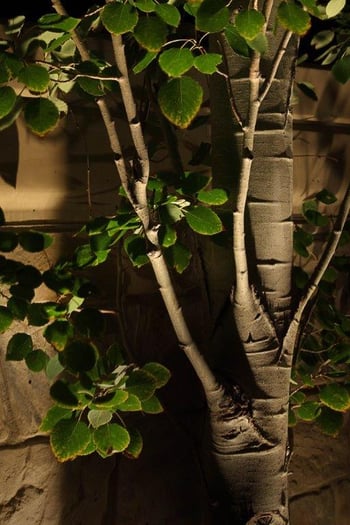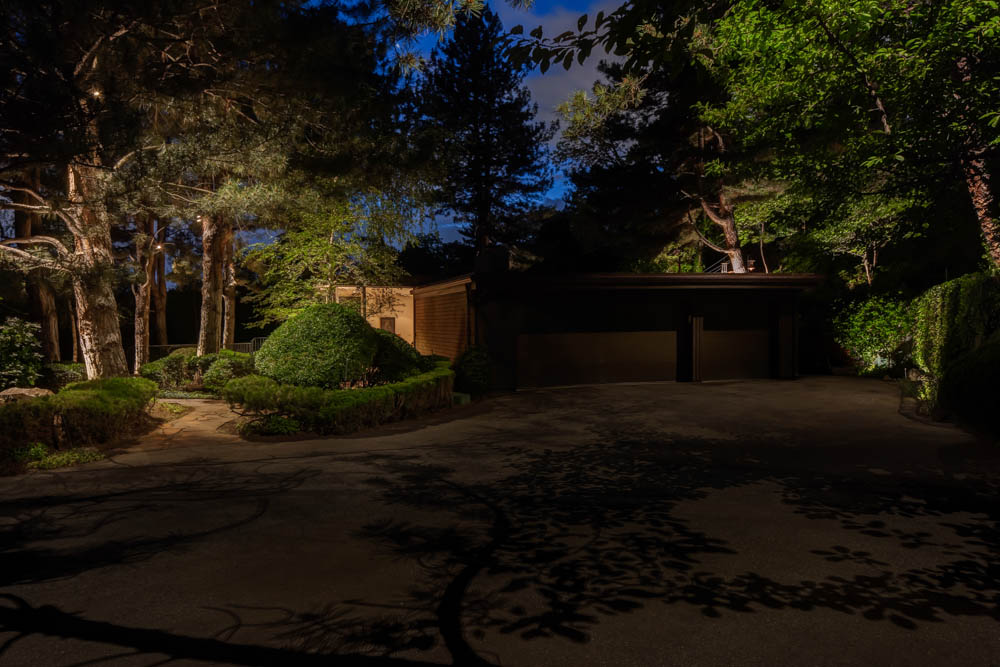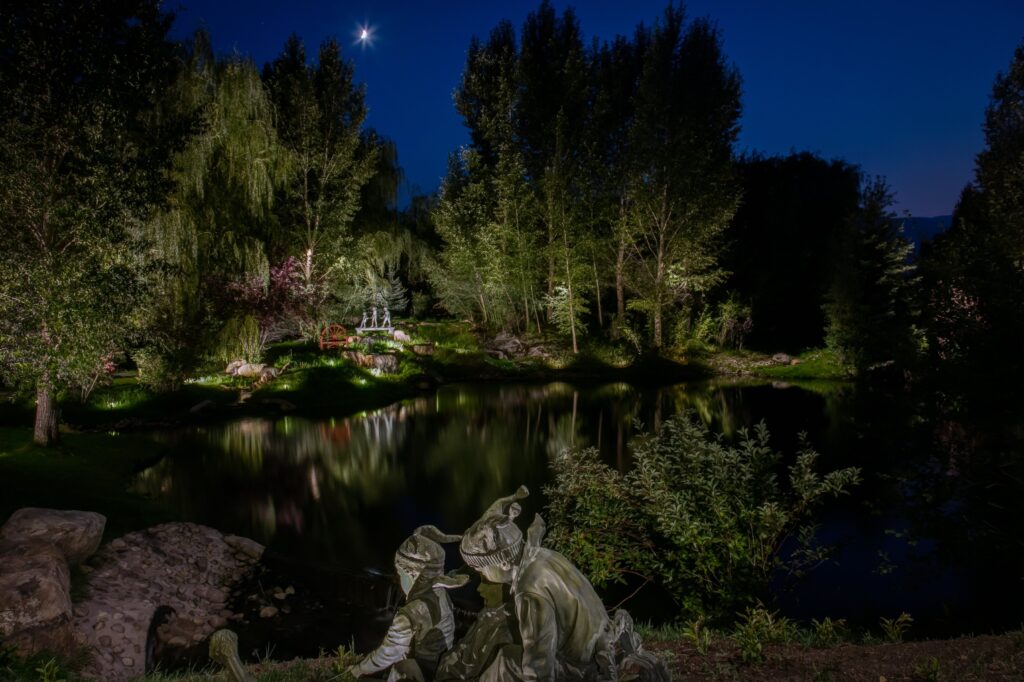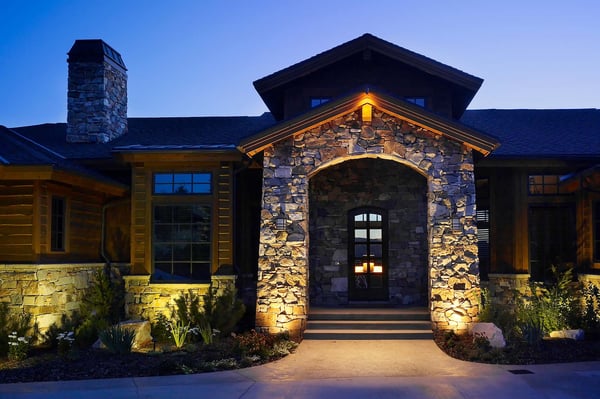Downlighting & Uplighting: When Do You Need Each In Your Landscape?
Downlighting vs. uplighting: this is common lingo in the landscape lighting world. What’s the difference? How do you know what type of lighting to use where?
Deciding all this is part of the fun — and challenge — of landscape lighting.
It’s all about direction. In uplighting, landscape lights are mounted below or at ground level, shining the light upward.
To downlight, you might place a fixture high up, in the branches of a tree or beneath the eaves on your house, so the light shines down. The higher the light, the wider space it tends to illuminate.
So many possibilities! Let’s take a look.
What Should You Uplight?

Certain areas outside your home are perfect for the effects of uplighting.
Trees, for instance. Lighting a beautiful tree, like a Japanese Maple for instance from the ground up shows off its interesting bark, branch structure and delicate leaves.
Architectural columns. Why not enjoy the beauty of your home’s architecture at night, too?
Lighting columns from below adds drama and can create interesting shadows on walls.
Garden features are great candidates for uplighting. Highlight a beautiful fountain, elegant statue or a prized plant with uplighting.
It automatically adds drama to your garden.
Uplighting With Well Lights Vs. Directional Uplights
It’s worth noting the difference between uplighting with well lights — fixtures installed even with the surface of the ground — and directional uplighting, which features fixtures above ground atop short posts.
Each serve specific purposes.
For instance, we wouldn’t use well lights in a flower bed. The plants would grow right over them and block the light. Beds of plants need lights that can rise a bit above the greenery.
But I love using well lights to light a lovely Japanese maple. A well light can snug in close, right at the base of the trunk, and shine straight up, highlighting the exquisite lacy foliage.
We often add hoods or “lids” to directional uplights to prevent glare and distracting hot spots.
What Should You Downlight?
Some features are best lit by downlighting.
Think about a bed of beautiful hosta, with their big textured, variegated leaves. Lighting them from above shows them off after dusk.
Outdoor seating is perfect for downlighting. We often use it under benches and seating walls to cast subtle lighting along pathways and patios. Not only does it cast a welcoming pool of light, but it offers an element of safety for people walking through.
When Downlighting Is The Practical Solution
Sometimes downlighting is just the more practical choice.
One of our clients has three active boys, all under the age of 10. Their boisterous activity around the property had trashed the family’s traditional directional path lights — fixtures atop short posts lining their paths.
The solution? Lighting those areas from above, with downlighting installed in trees overhead. No fixtures to trample. Just beautiful dappled light spilling onto the paths.
The Magic Of Moonlighting

Moonlighting is a type of downlighting that offers a specific look. You got it — it looks like moonlight.
A light fixture is placed high up in a tree and angled downwards. The effect? Moonlight shining down through the branches. It feels natural, and creates a lovely effect as the leaves and branches create shadow patterns on the ground.
When Mother Nature gives me a beautiful canopy of trees, my mind goes there automatically. Lighting from overhead feels natural to our eye.
It’s the way nature does it, with both the sun and the moon.
When Should You Use Moonlighting?
Think about the spots around your house that would be perfect under a full moon. When the moon doesn’t cooperate, no problem — you can create your own. Patios are ideal for moonlighting. If there are trees overhead, they’ll create intriguing shadows as the light filters down through them, and you can happily entertain your guests under your “moonlit” sky.

Swimming pools? This is a no brainer. Who doesn’t love a moonlit swim?
I love to use moonlighting over driveways. Think about the scenarios that happen in your driveway. You’re carrying a load of heavy groceries in bags about to burst. You’re toting a cranky toddler. You’re shuffling to the door after a stressful day of work.
It will all seem better beneath your own personal moonlight.
Will Moonlighting Damage My Trees? No Worries
Homeowners are often understandably concerned about mounting lights in their trees.
We only install lights in mature trees we know can support them. We use stainless steel screws so they don’t cause disease or damage. We’ll return to adjust the screws as the tree grows as part of our annual service agreement.
We hide the cable on the non visible side of the tree so you don’t even know it’s there.
Can’t Choose? Use Both!
Downlighting vs. uplighting? You don’t always have to choose.
A beautifully lit garden might feature moonlighting filtering through the trees, as well as uplighting and downlighting to highlight dramatic plants and statuary.
In fact, you often need both, working in harmony together.
If you use downlighting by itself, you can see the cone-shaped area where the light begins. Add uplighting to the mix, and that line of demarkation disappears. You can’t really see where one source ends and the other begins. You just see beautiful, natural looking light.
A residence we transformed in Park City, Utah demonstrates how using both can work great in a front entry.

This home has a beautiful stone facade and stone columns flanking the front porch.
We installed uplighting at the base of each column to highlight the stone work, and added downlighting on the gable over the front porch.
The two sources of light, working together, create a warm, inviting pool of light on the entryway.
Give Us A Call
To learn more about how down lighting and uplighting can work together to beautify your landscape, call us at (801) 440-7647 to schedule a free consultation, or fill out our simple contact form.
Located in Midvale, Landscape Lighting Pro of Utah serves customers throughout Utah’s residential areas, including Salt Lake City, Park City, Draper and Holladay. Our outdoor lighting portfolio includes projects from Salt Lake County and Utah County, to Davis County and Summit County — and beyond.
Salt Lake City (Midvale)
801-440-7647
St. George
435-932-6627
©2025 Landscape Lighting Pro
Privacy Policy
Cookie Policy